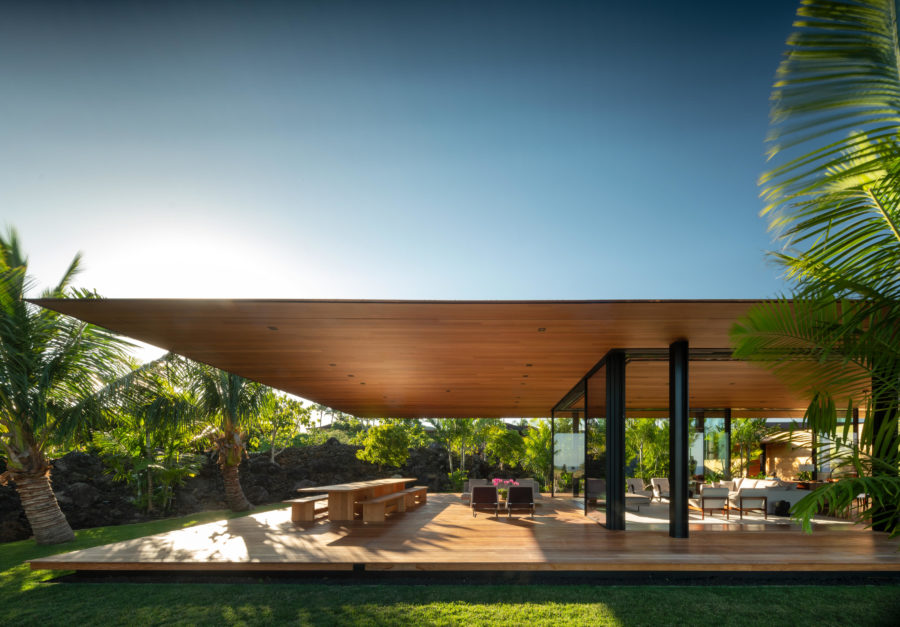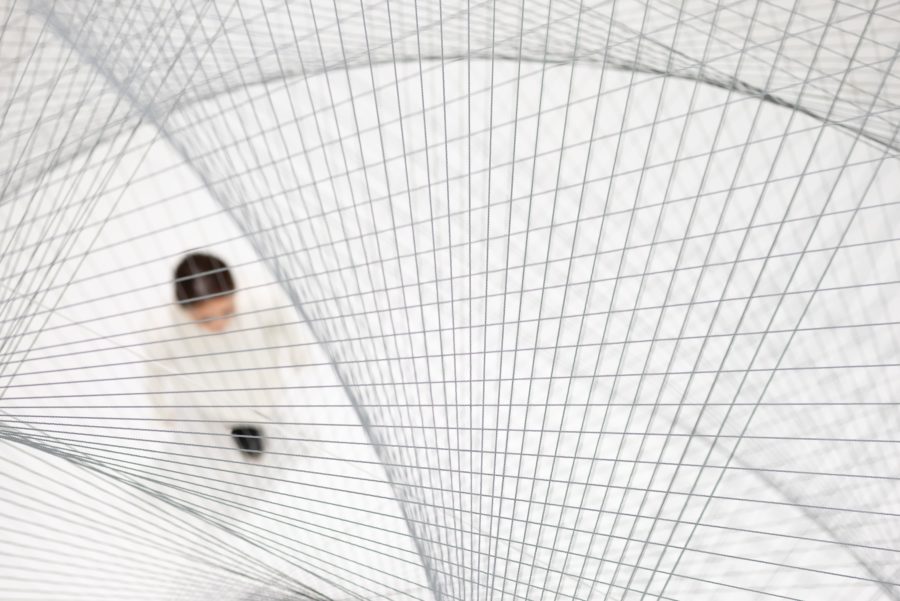京町家の要素を継承しつつ新たな時代に求められる事柄にどのように対応していくか。この問いを静かに自問し、建てられたのが「再定義された町家」である。
京都市中京区の旧市街地型美観区域に位置した、東西に細長い敷地で、建築高さは10m以下とし、勾配屋根と庇を取り入れるなどの建築規定が課されている。
建て主は、特定の土地や民族で生まれる「ORIGINAL」に興味を持っており、伝統的町家のもつ「地味さ」に秘められたデザイン性の高さや無駄な要素を取り除いた実質的で合理的な美しさに強く惹かれていた。そこで、京都の厳しい建築規定を自由にデザインできない障害ではなく再定義する機会とし、100年、200年の耐久性と構造性に加え、省エネルギー性能やデザイン性においても時代に影響されない持続性のある設計を試みた。
全体的な構造は、京町家などで多く見られる勾配屋根と庇を基本として設計し、耐久性のために鉄筋コンクリート構造を採用した。屋根と庇は古くから京町家に使われている日本瓦一文字葺、外壁は外断熱材に濃目のグレー塗装で、外観を周りの環境に溶け込ませた。
内部の構成も伝統的町家と同じように、通りに面した西棟1階と2階が仕事場、東棟1階と2階に住居空間が配されている。西棟と東棟の間に苔庭(1階)とテラス(2階)を挟むことで、仕事場と住まいの距離を保った。また、炊事場の吹き抜けや玄関から裏に通じる通路(はしり)や、苔庭と水庭から光と風を取り込む手法も伝統的町家にならっている。既存の井戸水は苔庭散水と水庭の水盤に活用している。
一方で、現代における課題である環境的な持続可能性を追求すべく、省エネルギー住宅の要素を組み込んだ。ペアガラスサッシを用いた高性能な外断熱気密構造を採用し、コンクリートの蓄熱性の利用や熱交換換気システムを導入することで、消費電力を約70%削減できるようになっている。
内装においても、伝統とモダン、和と洋、繊細さと荒々しさ、豊かさと質素感(わびさび)という相反する要素を1つの空間に組み込む試みを行った。
コンクリート型枠に使用済みの合板を再利用することで表面に荒々しさが残った内壁とし、数寄屋造りの障子を組み込み温かみを出した。さらに、デザイナーである家主自身が手がけた照明器具とナガ族、ペルシャ遊牧民の古いテキスタイルコレクションで柔らかさを加えている。また、キッチンと化粧室のカウンターにはひと昔前に使われていた研ぎ出し技法を継承し、モダンな空間に旧式の感覚を取り込んだ。
長い伝統に裏打ちされた持続可能性を保ちつつ、現代の課題を踏まえた「サステイナブルな町家」を多角的に再定義する試みは、年月を経ても続いていくだろう。(今村悦美)
Redefined machiya that weaves together tradition and contemporary practice
How can one incorporate contemporary demands into a traditional architecture like the Kyo-machiya while keeping its classic elements? “Redefined Machiya” is a house that stems from one designer’s quiet thinking sessions within this context.
The house stands on a long and narrow plot of land that stretches from east to west in Nakagyo Ward, Kyoto City. The surrounding neighborhood is designated as an “Old Urban Landscape Aesthetic Area” with a number of architectural restrictions, among them – buildings must be ten meters or less in height and incorporate sloped roofs and eaves. The owner/designer of the house has always admired a functional, practical aesthetic that eschews all unnecessary elements as well as loving the sophisticated design found hidden in the “plainness” of a traditional machiya. Therefore, when faced with Kyoto’s strict architectural regulations, she decided to treat it as an opportunity to redefine the machiya rather than as an obstacle to design freely and took on the challenge to search for a sustainable design, not only for durability and structural reasons, but also to build energy-saving performance within a modern aesthetics.
The design of the overall structure is constrained by the city’s building regulations, incorporating a sloped roof and eaves (which is a style often seen in Kyo-machiya) while changing to a poured-in-place concrete structure for durability. The roof and eaves are finished with Japanese roof tiles traditionally used for Kyo-machiya. The external walls are covered with a thermal insulation layer painted in a dark gray to blend in with the surrounding environment.
The interior structure is similar to that of a traditional Kyo-machiya – the 1st and 2nd floors of the east wing face the street and act as working spaces, while the 1st and 2nd floors of the west wing are residential. The center moss garden (1st floor) and terrace (2nd floor) between the eastern and western structures provide open space between the work and private zones. In addition, the atrium of the kitchen, the passage leading from the entrance to the back of the house, and the center moss garden and rear water garden are designed specifically to bring in more light and air in homage to traditional Kyo-machiya design. Both gardens are serviced with water from a pre-existing well on the property.
Elements of energy-saving construction were also applied in order to address contemporary issues such as environmental sustainability. For example, the house is built using a high-performance thermal insulation envelope over a poured-in-place concrete structure. It is also airtight and uses double-glazed windows. The effective use of the thermal insulating properties of concrete and the internal heat exchange ventilation system together can reduce the building’s energy consumption by an estimated 70%.
The attempt to incorporate contradictory elements – tradition and modernity, Japanese and Western styles, delicacy and roughness, richness and simpleness (Japanese “wabi-sabi”) – continues in the interior design.
The rough surface of concrete walls, an effect created by utilizing used plywood for the concrete forms, was balanced with the warmth of sukiya zukuri shoji screens built into the inner walls. The designer’s collection of lighting fixtures of her own design and old textiles of Naga and Persian origin were strategically placed to add softness to the space. The kitchen and bathroom countertops are terrazzo made using a traditional technique that adds texture to an otherwise minimalist modern space.
The designer’s quest to redefine the Kyo-machiya, a delicate balance satisfying contemporary sustainability and traditional demands, will continue for years to come. (Etsumi Imamura)
【中京の家】
所在地:京都市中京区
用途:戸建住宅、アトリエ、デザイン事務所
クライアント:個人
竣工:2018年
設計:IMAMURA DESIGN、クル建築事務所
担当:今村悦美
構造設計:アスコラル構造研究所
施工:デザオ建設
省エネルギー構造計画コンサルタント:京都工芸繊維大学大学院 芝池英樹 准教授
外断熱システム:高本コーポレーション
熱交換換気システム:信越BIB
造園設計、施工:IMAMURA DESIGN、達造園
撮影:下村康典、米村栄一、今村悦美
工事種別:新築
構造:鉄筋コンクリート造
規模:地上2階
敷地面積:260.00m²
建築面積:176.05m²
延床面積:328.09m²
設計期間:2015.09-2017.04
施工期間:2017.12-2018.10
【NAKAGYO HOUSE】
Location: Nakagyo-ku, Kyoto, Japan
Principal use: Private house, Artist studio, Design office
Client: Individual
Completion: 2018
Architects: IMAMURA DESIGN, Kuru Architectural Office
Design team: Etsumi Imamura
Structure engineer: Asukoraru Structural Engineering Laboratory
Contractor: Dezao
Consultant for energy efficiency planning & engineering: Associate Professor Hideki Shibaike of Kyoto Institute of Technology
External wall insulation construction: Takamoto Corporation
Heat recovery ventilation system: Shinetsu BIB
Landscape planning, Construction: IMAMURA DESIGN, Tatsuzoen
Photographs: Yasunori Shimomura, Eiichi Yonemura, Etsumi Imamura
Construction type: New Building
Main structure: Reinforced Concrete construction
Building scale: 2 Stories
Site area: 260.00m²
Building area: 176.05m²
Total floor area: 328.09m²
Design term: 2015.09-2017.04
Construction term: 2017.12-2018.10








